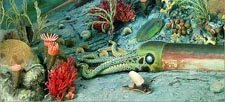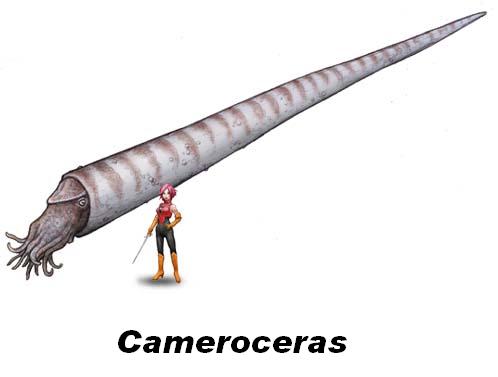 |
 |
 |
 |
 |
Produced
by the Population Genetics and Evolution class, Furman University |
||||
 |
 |
 |
 |
 |
Produced
by the Population Genetics and Evolution class, Furman University |
||||
 |
The
Ordovician: Cameroceras |
 |
||
| Cameroceras was a genus of giant "orthocone" (straight-coned) cephalopod, with the largest member reaching an estimated 9m in length (Wikipedia 2010). Its huge size probably indicates that it was at the top of the food chain - an "apex predator" - that fed on other nautiloids and large eurypterids. With their long bulky shell, however, it is unlikely that Cameroceras were active, hunting predators. Rather, it may have been a sit-and-wait predator, or may even have foraged by crawling or floating on the sea floor. Some buoyancy may have been produced by increasing the gas content in their chambered shell, like in modern nautiloids. With the demise of the Anomalocarids of the Cambrian, the top-predator niche was vacant and waiting. The radiation of the nautiloid molluscs represents one of the most dramatic events in the Ordovician period. Page by Wade Worthen |
 |
| Cameroceras. Photo from: Tonmo: The Octopus New Magazine | |
|
Tonmo. 2010. Cameroceras. Tonmo, the Octopus New Magazine. Accessed Feb. 18, 2010. Wikipedia. 2010. Cameroceras. Accessed Feb 18, 2010. |